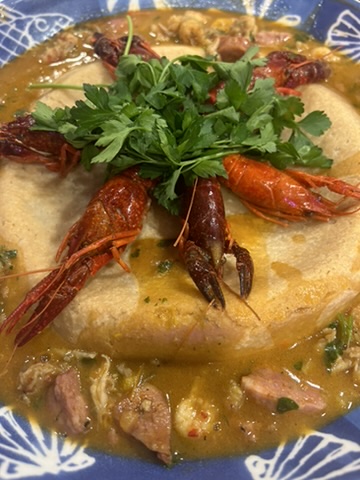Article by Lisa Tagal, recipe from Mark Tagal
The American Red Swamp Crawfish (Procambarus clarkii) has been part of the American diet for hundreds, if not thousands, of years. You may know them under one of their many names, such as crayfish, crawdads, or mud bugs. Did you know a wide variety of these freshwater crustaceans are found on every continent except Africa and Antarctica? In the U.S., they were gathered by Native Americans by hand or with woven reefs baited with venison; tribes such as the Houma have relied on this freshwater crustacean since time immemorial. The Houma tribe originated in Mississippi but migrated to Louisiana, specifically along the southeastern coast. The name “Houma” is a Choctaw word meaning “red,” and the tribe’s symbol was a crawfish. The feisty, small crawfish stands its ground when confronted with danger. It simply puts up its claws to do battle instead of fleeing. No wonder it was used as their war emblem, representing bravery.
Louisiana’s passion for crawfish extends far beyond its culinary appeal. It is a cultural cornerstone woven into every part of the state’s history, identity, agriculture, and religious traditions – you could say it is Louisiana’s way of life. Crawfish is more than just a meal – it’s a food group unto itself, a symbol of community, and a central element in the celebrations that bring people together across the state. The crawfish tradition embodies the heart of Louisiana culture: a sense of unity and shared experience.
Here is a list of ways the Red Swamp crawfish have dominated the Louisiana landscape, giving you an idea of their importance.
- Native Americans: The indigenous peoples of Louisiana were the first to harvest and eat crawfish.
- Acadians: When they arrived in the 1700s, they settled along the bayous, where crawfish became a cheap and abundant food source.
- Commercial Harvest: The first recorded commercial harvest of crawfish in the United States occurred in 1880 in Louisiana.
- Farming: Farming began in the 1940s when farmerʻs would flood open fields to create favorable crawfish habitat. In the 1960s, rice farmers introduced a new agricultural practice by cultivating crawfish in their ponds during the off season. This created an early form of polyculture where both aquaculture and land-based crops could be grown in the same area. Louisiana leads the nation in producing this delicious freshwater crustacean, harvesting more than 100 million pounds a year.
- Lenten Tradition: Crawfish became a culinary fixture during Lent when Catholics abstain from meat on Fridays.
- Crawfish Boils: Crawfish boils have evolved into a beloved springtime tradition in Louisiana, where countless neighborhoods and families host them. The dish takes center stage at springtime birthday parties, graduation celebrations, and family gatherings, and it’s also a standout culinary experience for many visitors to the state.
- Crawfish Festivals: The Breaux Bridge Crawfish Festival, held annually since 1960, celebrates the region’s crawfish culture. 1959 Breaux Bridge was named the “Crawfish Capital of the World.”
- Vietnamese Influence: After the arrival of Vietnamese refugees, crawfish was infused with a blend of Cajun and Vietnamese culinary traditions, creating unique new dishes.
- Crawfish Étouffée: Many culinary historians trace the origin of crawfish étouffée to Breaux Bridge in the early 20th century, cementing the dish as a Louisiana classic.
An excellent way to enjoy this flavorful crustacean is in a baked, savory pie, simply called Crawfish pie. Crawfish are an excellent source of high-quality protein, low in calories, fat, and saturated fat, and a good source of vitamins. Their muscle fibers are shorter than those of red meat and more easily digested. Here is a tried and true recipe to introduce you to Louisiana’s beloved mud bugs.
CRAWFISH PIE RECIPE
This recipe takes time, especially if this is your first attempt at making crawfish pie. However, depending on your dining plans, some time-saving options are listed. You can make the pie filling first or the pie crust, as that is a personal preference. Another option is to pre-cook the pie crust bottom. This recipe did not include that step; however, it was accounted for by cooking the entire dish in a cast-iron pan for thorough cooking.
Prep Time: 20 minutes Cook Time: 1 hour
Cooling Time: 35-40 minutes Total Time: 4 hours, 50 minutes
Pie Filling Ingredients
- ½ cup salted butter
- ½ cup of peanut oil
- 1 cup flour
- 2-3 cups of stock
- Stock made with crawfish heads is best, but chicken stock will also work.
- 1 large onion, diced (about 1 1/2 cups)
- ½ bell pepper, seeded and diced (about 1/2 cup)
- 4 cloves garlic, minced
- 1 teaspoon salt
- ¾ teaspoon ground black pepper
- ½ teaspoon crushed red pepper
- 2 pounds of crawfish tail meat
- ½ cup chopped green onion
- 2 tablespoons chopped parsley
- 1 pound andouille sausage
- 2 tablespoons tomato paste
Pie Filling Directions
- Preheat oven to 400 degrees.
- Make a rue. Melt butter in a pan, then add the peanut oil and flour. Mix constantly. This rue is not as dark as a gumbo rue, but you don’t want it white. When you drag a spoon across the bottom of the pan, and the mixture separates, it is done.
- Add all the rest of your ingredients EXCEPT the crawfish. They will shrink. Let this mixture simmer for at least an hour. You want to reduce the water that came in with the veggies.
- After about 1 hour, it is ready for the pie crust. At this point, I like to set about ⅓ of the mixture aside and save it for service. The mixture will thicken when baking, so having some sauce on the side is nice.
Pie Crust Ingredients
You can use whatever pie crust you prefer. If you donʻt have the time or energy to make the crust from scratch, you can use frozen pie crust. If you want a lattice top or an entire coverage crust top, purchase two rounds of 9” frozen pie crust.
I like a homemade, southern-style pie crust, so it does involve lard. I prefer to cover the entire pie with a crust on top.
- 1-2 cups of flour
- 1 stick of cold butter
- 1 cup of lard
- Salt to taste
- Icewater
Pie Crust Directions:
- In a food processor, cut in cold butter with half of your flour and pulse until it resembles wet sand.
- Add the rest of the flour, lard, and salt. Pulse a few more times to combine everything. Form the dough into a ball with your hands. If it is too dry, add small amounts of ice water, but the less you handle your crust, the flakier it will be. Let it rest for about 20 minutes.
Time-Saving Shortcuts
- Premade frozen pie crusts can be cut into strips, woven in a lattice pattern, or fully covered on top of the pie. Brush the top crust with an egg wash to help it brown.
- Purchase pre-made ingredients to make it easier. There’s no shame in store-bought pie crust or pre-chopped veggies if those help you make this recipe faster!
- Bake the pie in advance, then store it in the fridge for 2-3 days. Before guests arrive, reheat it in the oven at 350℉ for 20-30 minutes or until warmed through.
Final Preparation Directions
- Assemble the crawfish pie once the pie filling and pie crust are done.
- Bake until a golden crust forms.
- Garnish with a few whole crawfish, fresh parsley, and a ladle full of sauce.
- Now go, “Allons manger!” Let’s eat!!!
- If you want to embrace Louisiana’s Cajun food and fun-loving nature, you could say one of these commonly spoken phrases:
“Laissez les bons temps rouler” – Translation: Let the good times roll!
“Ça c’est bon” – Translation: That is good!
“Boudin” – Translation: Cajun word for delicious!





